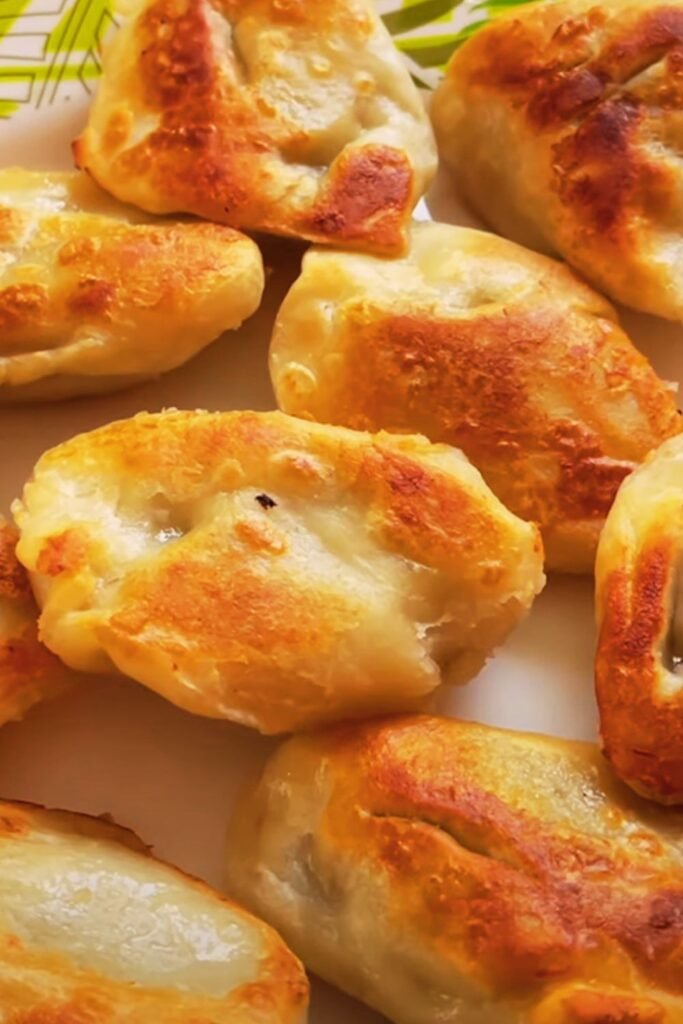There’s something incredibly satisfying about biting into a perfectly cooked pierogi. That tender dough giving way to a savory filling, the slight tang of sauerkraut balancing the earthiness of potato, all topped with caramelized onions and a dollop of sour cream. As someone who grew up watching my grandmother meticulously craft these Polish dumplings, I’ve developed a deep appreciation for this humble yet extraordinary dish.
Today, I’m excited to share my comprehensive guide to making authentic potato and sauerkraut pierogi from scratch. This isn’t just any recipe—it’s a journey into Polish culinary tradition that has been refined through generations of family cooking.
The Cultural Significance of Pierogi
Pierogi hold a special place in Polish cuisine and culture. These crescent-shaped dumplings have been a staple in Poland since at least the 13th century. While many countries have their own version of filled dumplings—think Italian ravioli, Chinese jiaozi, or Russian pelmeni—pierogi have a distinct character that reflects Poland’s agricultural heritage and resourceful cooking traditions.
Traditionally, pierogi were considered peasant food, made with simple, affordable ingredients that could sustain hardworking families through harsh winters. The potato and sauerkraut filling (called “ruskie” in Polish) became particularly popular because these ingredients were readily available and could be stored for long periods.
In my family, making pierogi was never just about food—it was an event. I remember gathering around my grandmother’s kitchen table, where three generations would work together, sharing stories and laughter as we formed hundreds of dumplings for holiday meals. This communal preparation is as much a part of the pierogi tradition as the recipe itself.
Essential Ingredients for Perfect Pierogi
Before we dive into the cooking process, let’s talk about what makes exceptional pierogi. Quality ingredients make all the difference, especially for a dish with relatively few components.
For the Dough:
- All-purpose flour: The backbone of our dough, providing structure while remaining tender
- Eggs: Adding richness and helping bind the dough
- Salt: Enhancing flavor throughout
- Water or milk: Providing moisture to form a pliable dough
- Sour cream: My grandmother’s secret for extra tenderness
For the Filling:
- Russet potatoes: Their starchy quality creates the perfect filling texture
- Sauerkraut: Traditional Polish sauerkraut has a distinct flavor profile—look for refrigerated varieties rather than canned when possible
- Onions: Yellow onions provide the best flavor when caramelized
- Butter: Essential for sautéing and adding richness
- Farmer’s cheese (optional): Some versions include this mild, fresh cheese
- Salt and pepper: For seasoning to taste
- Dried mushrooms (optional): For an earthy depth of flavor
For Serving:
- Butter: For pan-frying the cooked pierogi
- Onions: Sliced and caramelized to golden perfection
- Sour cream: The traditional cooling accompaniment
- Fresh herbs: Dill or parsley add a bright, fresh note
The Perfect Pierogi Dough
Creating the ideal pierogi dough is part science, part art. It should be elastic enough to stretch without tearing but sturdy enough to hold the filling. Through years of practice, I’ve developed a foolproof method that consistently produces perfect results.
Ingredients for the Dough:
- 4 cups all-purpose flour
- 1 teaspoon salt
- 2 large eggs
- 3/4 cup sour cream
- 1/2 to 3/4 cup water (as needed)
Step-by-Step Dough Preparation:
- In a large bowl, whisk together the flour and salt to distribute evenly.
- Make a well in the center of the flour mixture.
- Add the eggs and sour cream to the well.
- Begin mixing with a fork, gradually incorporating the flour from the sides.
- Add water a little at a time as you mix, until the dough starts coming together.
- Turn the dough onto a floured surface and knead for about 5-7 minutes, until smooth and elastic.
- Cover the dough with a damp cloth or plastic wrap and let it rest for at least 30 minutes.
This resting period is crucial—it allows the gluten to relax, making the dough easier to roll out and less likely to spring back when you’re cutting circles.
The Traditional Potato and Sauerkraut Filling
The filling is where you can truly make pierogi your own. The combination of potato and sauerkraut creates a perfect balance of creamy and tangy flavors. Here’s how to prepare this classic filling:
Ingredients for the Filling:
- 2 pounds russet potatoes
- 1 pound sauerkraut
- 2 medium onions, finely diced
- 4 tablespoons butter, divided
- 1/4 teaspoon freshly ground black pepper
- Salt to taste
- 1 tablespoon dried mushroom powder (optional)
Step-by-Step Filling Preparation:
- Peel potatoes, cut into chunks, and cook in salted water until fork-tender (about 15-20 minutes).
- While potatoes are cooking, rinse sauerkraut under cold water to reduce sourness if desired. Drain thoroughly and chop finely.
- In a skillet, melt 2 tablespoons of butter and sauté half the diced onions until golden (about 10 minutes).
- Add sauerkraut to the onions and cook for another 15 minutes, stirring occasionally. The moisture should evaporate, and the sauerkraut should become tender.
- In another pan, sauté the remaining onions in 2 tablespoons of butter until caramelized.
- Drain the cooked potatoes thoroughly and mash them while still hot.
- Combine the mashed potatoes with the sauerkraut mixture and caramelized onions.
- Season with salt, pepper, and mushroom powder if using.
- Allow the filling to cool completely before assembling the pierogi.
The key to exceptional filling is balance—the potatoes should be smooth but not gluey, the sauerkraut should retain some texture, and the onions should add sweetness without overwhelming the other flavors.

Assembling Your Pierogi
This is where patience and technique come into play. Properly assembled pierogi will cook evenly and hold their filling without bursting. Here’s my step-by-step approach:
Assembling Process:
- On a lightly floured surface, roll out the rested dough to about 1/8 inch thickness.
- Using a 3-inch round cutter or a glass with a thin rim, cut out circles from the dough.
- Place about 1 tablespoon of filling in the center of each circle.
- Moisten the edge of the dough circle with water using your fingertip.
- Fold the dough over to create a half-moon shape.
- Press the edges firmly to seal, making sure no filling is caught in the seam.
- For a decorative touch, crimp the edges with the tines of a fork or pinch them into a rope pattern.
- Place the formed pierogi on a floured baking sheet, making sure they don’t touch each other.
| Common Pierogi Mistakes | How to Avoid Them |
|---|---|
| Tough dough | Don’t overwork the dough; knead just until smooth |
| Pierogi bursting during cooking | Ensure edges are completely sealed and don’t overfill |
| Dough sticking to surface | Keep work surface and pierogi well-floured |
| Uneven cooking | Make all pierogi roughly the same size |
| Pierogi sticking together | Place on floured surface without touching |
The Art of Cooking Pierogi
Properly cooking pierogi is essential to achieving that perfect balance of tender dough and flavorful filling. The traditional method involves boiling and then pan-frying for the best texture and flavor.
Cooking Instructions:
- Bring a large pot of salted water to a gentle boil.
- Carefully drop in the pierogi, a few at a time, making sure not to overcrowd the pot.
- Stir gently with a wooden spoon to prevent sticking.
- Cook until the pierogi float to the surface, then continue cooking for about 2-3 minutes more.
- Remove with a slotted spoon and place on a plate lined with paper towels to drain.
- In a large skillet, melt 3-4 tablespoons of butter over medium heat.
- Add sliced onions and sauté until golden brown.
- Add the boiled pierogi to the skillet and pan-fry until golden and crispy on both sides, about 2-3 minutes per side.
For the best experience, serve pierogi immediately after pan-frying, when they’re at their most flavorful. The contrast between the crispy exterior and tender, steaming interior is absolutely divine.

Serving Suggestions and Traditional Accompaniments
While pierogi are delicious on their own, traditional Polish serving methods enhance their appeal. Here are my favorite ways to serve potato and sauerkraut pierogi:
Classic Serving Style:
- Top with caramelized onions
- Add a dollop of sour cream
- Sprinkle with fresh dill or parsley
- Serve with a side of extra sauerkraut for those who enjoy a tangier flavor
Complete Polish Meal Suggestions:
- Pair with a simple cucumber salad dressed with sour cream and dill
- Serve alongside clear beet soup (barszcz czysty)
- Include pickled vegetables as a side dish
- For dessert, offer a fruit compote of stewed seasonal fruits
Modern Twists:
- Top with crispy bacon bits and chives
- Serve with a mushroom gravy
- Add a side of roasted root vegetables
- Try a dollop of horseradish cream instead of plain sour cream
Storage, Freezing, and Reheating Tips
One of the best things about pierogi is that they freeze beautifully, allowing you to make a large batch and enjoy them for months to come. Here’s how to properly store, freeze, and reheat them:
Refrigerating Fresh Pierogi:
- Place uncooked pierogi in a single layer on a floured plate or baking sheet
- Cover with plastic wrap
- Refrigerate for up to 24 hours before cooking
Freezing Pierogi:
- Place uncooked pierogi in a single layer on a floured baking sheet
- Freeze until solid (about 2 hours)
- Transfer to freezer bags or airtight containers
- Label with the date and filling type
- Store in the freezer for up to 3 months
Cooking Frozen Pierogi:
- Do not thaw before cooking
- Drop frozen pierogi directly into boiling water
- Cook until they float and then for 3-4 minutes longer
- Drain and pan-fry as usual
Reheating Leftover Cooked Pierogi:
- In a skillet: Melt butter, add pierogi, and heat until warm and crispy
- In the oven: Place on a baking sheet, brush with butter, and bake at 350°F (175°C) for 10-15 minutes
- In the microwave: Place on a microwave-safe plate, cover with a damp paper towel, and heat in 30-second intervals until warm
| Storage Method | Duration | Special Instructions |
|---|---|---|
| Refrigeration (uncooked) | Up to 24 hours | Keep pierogi separated and floured |
| Refrigeration (cooked) | 3-4 days | Store in airtight container |
| Freezer (uncooked) | Up to 3 months | Flash-freeze before bagging |
| Freezer (cooked) | Up to 2 months | Cool completely before freezing |
Troubleshooting Common Pierogi Problems
Even experienced cooks can encounter issues when making pierogi. Here are solutions to the most common problems:
Dough Issues:
- Too sticky: Add flour gradually until it reaches the right consistency
- Too dry: Add a small amount of water or an extra egg yolk
- Tough dough: You may have overworked it; let it rest longer before rolling
- Dough tears easily: The gluten may not be developed enough; knead a bit longer
Filling Issues:
- Too wet: Cook the filling components longer to evaporate excess moisture
- Bland filling: Add more caramelized onions, salt, pepper, or dried mushroom powder
- Filling leaks during cooking: Ensure edges are well-sealed and not too thin
Cooking Problems:
- Pierogi stick together: Add them to the water one by one and stir gently
- Pierogi burst during boiling: The water may be boiling too vigorously; reduce to a gentle boil
- Pierogi are soggy after frying: Make sure to drain well after boiling and use a hot skillet
Remember that making perfect pierogi takes practice. Don’t be discouraged if your first batch isn’t perfect—even experienced Polish cooks expect to refine their technique over time.

Seasonal and Regional Variations
While potato and sauerkraut pierogi are classic, Poland has many regional variations worth exploring. Learning about these can inspire you to create your own unique combinations:
Regional Polish Variations:
- Silesian Pierogi: Often made with a higher proportion of potato to sauerkraut
- Northeastern Polish Style: May include wild mushrooms gathered from local forests
- Warsaw Style: Sometimes includes a small amount of smoked meat in the filling
- Southern Polish Variations: May be served with a topping of fried lard with cracklings instead of butter and onions
Seasonal Adaptations:
- Spring: Add fresh herbs like chives and parsley to the filling
- Summer: Serve with a side of fresh cucumber salad
- Fall: Incorporate seasonal mushrooms into the filling
- Winter: Pair with hearty meat stews for a complete cold-weather meal
Health Benefits and Nutritional Information
While pierogi are certainly a comfort food, they also offer some nutritional benefits when made with quality ingredients:
Nutritional Highlights:
- Potatoes provide vitamin C, potassium, and complex carbohydrates
- Sauerkraut is rich in probiotics, vitamin C, and fiber
- Whole eggs in the dough offer protein and essential vitamins
- When pan-fried in moderation, the dish provides satisfying fats that help with nutrient absorption
Nutritional Information (per serving of 4 pierogi):
| Nutrient | Amount |
|---|---|
| Calories | 320-360 |
| Protein | 8-10g |
| Carbohydrates | 45-50g |
| Fat | 12-15g |
| Fiber | 3-4g |
| Sodium | 400-500mg |
| Vitamin C | 15% DV |
| Iron | 10% DV |
Note: Values are approximate and may vary based on specific ingredients and preparation methods.
Making Pierogi Healthier:
- Use whole wheat flour for part of the dough
- Reduce butter and use olive oil for frying
- Increase the ratio of sauerkraut to potato for more probiotic benefits
- Serve with a large side salad to create a more balanced meal
Questions and Answers About Pierogi
Q: Can I make pierogi dough ahead of time?
Yes, you can make the dough up to 24 hours in advance. Keep it well-wrapped in plastic to prevent drying out, and let it come to room temperature before rolling.
Q: Why do my pierogi stick to the bottom of the pot when boiling?
This usually happens when the water isn’t boiling enough before adding the pierogi or if you’re overcrowding the pot. Make sure the water is at a good boil and stir gently right after adding them.
Q: Can I air-fry instead of pan-frying pierogi?
Absolutely! Air-fry boiled pierogi at 380°F (190°C) for about 8-10 minutes, turning halfway through. Brush with a little butter first for best results.
Q: My grandmother used to make sweet pierogi. Is that authentic?
Yes! Sweet pierogi filled with fruits like cherries, blueberries, or sweetened farmer’s cheese are completely authentic in Polish cuisine. They’re typically served with sweetened sour cream and sometimes a sprinkle of sugar.
Q: How do I prevent my pierogi dough from becoming tough?
Don’t overwork the dough when kneading, make sure to let it rest properly, and handle it gently when rolling and cutting. The addition of sour cream also helps keep the dough tender.
Q: Can I make pierogi without eggs for a vegan version?
Yes, you can replace eggs with 3-4 tablespoons of aquafaba (the liquid from canned chickpeas) or simply omit them and add a bit more water. For the filling, use plant-based butter and skip the sour cream topping or use a vegan alternative.
Q: Why is my pierogi filling bland?
Proper seasoning is key. Make sure to add enough salt to both the potato and sauerkraut components. Caramelizing the onions thoroughly brings out their sweetness, which balances the tangy sauerkraut. Also, letting the filling rest for a few hours helps the flavors meld.
Q: How do I know when my pierogi are perfectly cooked?
When boiling, they’ll float to the surface after 2-3 minutes. Cook them for 1-2 minutes more after they float. When pan-frying after boiling, look for a golden-brown color and crispy edges.
Conclusion
Making pierogi with potato and sauerkraut filling is more than just preparing a meal—it’s participating in a cultural tradition that spans generations. While the process may seem labor-intensive at first, the satisfaction of creating these delicious dumplings from scratch is incomparable. The combination of tender dough, savory-tangy filling, and buttery caramelized onions creates a harmony of flavors that has stood the test of time.
I encourage you to gather friends or family for your pierogi-making session. Not only does this make the work go faster, but it also honors the communal tradition of pierogi preparation. Share stories, laugh together, and create memories as you fold these little pockets of joy.
Whether you’re connecting with your Polish heritage or simply exploring the diverse world of dumplings, these potato and sauerkraut pierogi are sure to become a favorite in your cooking repertoire. So roll up your sleeves, dust your countertop with flour, and embark on this delicious culinary adventure!